Discovering Australia's Unique Lemon Tart Recipes

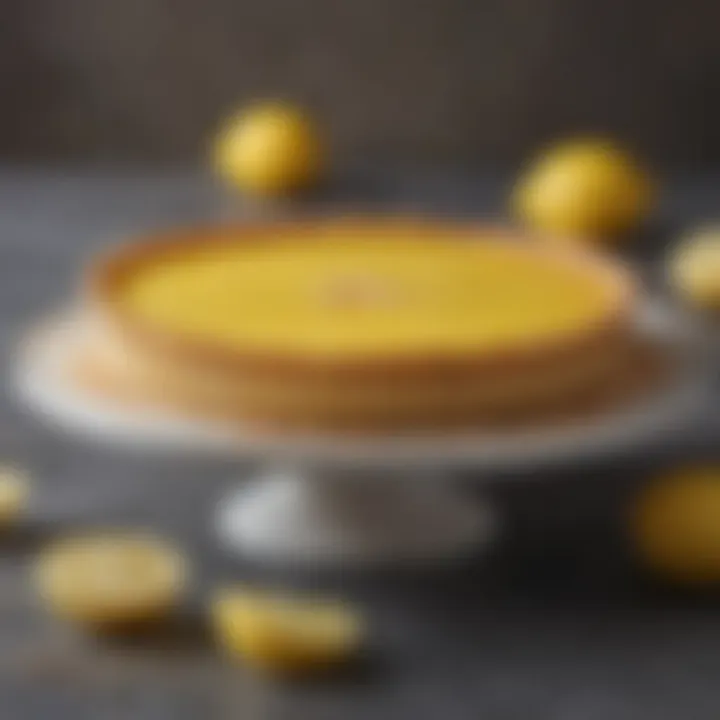
Intro
Lemon tart holds a cherished place in Australian culinary culture. Its bright, zesty flavor easily resonates with the country's love for fresh and vibrant desserts. Whether as a delightful end to a meal or a standout dessert at gatherings, this dish is incredibly versatile. Different Australian regions introduce unique twists on the classic recipe. Exploring these variations becomes a journey of discovery, appealing to both seasoned bakers and beginners alike.
In crafting a lemon tart, methodical attention to detail can be the secret to achieving the perfect balance between the tart's refreshing-but-sweet bite and its smooth texture. Also, the freshness of ingredients matters greatly. Leamos find strength in their vibrant use across various dishes in the country, showcasing the lemons’ roles in classic desserts. It allows us to reflect on each region's distinct flavors.
Recipe Highlight
Featured Recipe: Australian Citrus Lemon Tart
This lemon tart recipe accents fresh lemons’ zest and juice, combining tradition with a contemporary flair.
Essential Ingredients:
- 1 1/4 cups plain flour
- 1/2 cup unsalted butter, chilled
- 1/3 cup powdered sugar
- 2 eggs
- 1 cup caster sugar
- Zest and juice of 3 lemons
- Heavy cream or yogurt, for serving
Estimated Preparation Time:
About 40 minutes for preparation, plus 30 minutes for baking.
Servings:
Yields around 8 servings.
Step-by-Step Instructions
- Make the tart shell:
- Shape and Blind Bake:
- Prepare the lemon filling:
- Cool and Serve:
- Preheat the oven to 180°C (350°F).
- In a food processor, blend flour, butter, and powdered sugar until resembling coarse crumbs.
- Add one egg and mix until dough forms. This dough needs to chill for 30 minutes.
- Roll out the dough on a floured surface.
- Place it into your tart tin and p4ich the base. Add parchment and weights, then bake for 15 minutes.
- Remove weights and parchment, then bake for an additional 10 minutes until golden.
- In a bowl, combine 2 eggs, caster sugar, lemon juice, and zest.
- Whisk until smooth, then pour into the tart shell.
- Bake for 30-35 minutes until just set.
- Allow the tart to cool down completely before slicing.
- Serve chilled with a dollop of heavy cream or yogurt.
The success of a lemon tart relies on the balance of sweet and tart flavors, achieved by combining fresh ingredients wisely.
Variations and Substitutions
Adapt this recipe to suit specific preferences or dietary restrictions:
- Gluten-Free Alternative: Substitute plain flour with gluten-free flour blend, ensuring the consistency remains.
- Extra Zesty Lemon Flavor: Consider adding grapefruit or lime juice for a unique taste twist.
- Serving Ideas: This tart pairs beautifully with fresh fruit compote or even a scoop of lemon sorbet for added flair.
Time-Saving Cooking Tips
To maximize your efficiency:
- Pre-chop all ingredients and measure them in advance to streamline the process.
- Using kitchen gadgets like a pastry blender can save time in dough preparation.
- Take the opportunity to make more than one tart and freeze extras en lieu of last-minute rushes.
Nutritional Information
In one serving of the Australian Citrus Lemon Tart:
- Calories: Approximately 320
- Key Nutrients: Carbohydrates, proteins, and fats, along with vitamins C and E.
This tart may not fit certain stringent diets, but you can tailor it for discussions around health needs with straightforward ingredient swaps.
Preface to Lemon Tart in Australia
Lemon tart holds a cherished place within the culinary landscape of Australia. This dessert blends traditional recipes with local flavors, resulting in a variety that appeals to a wide audience. With the rise in popularity of homemade desserts, understanding lemon tart offers various benefits for food lovers and aspiring cooks alike.
One essential aspect that makes lemon tart significant is its versatility in occasions. Whether for a dinner party, a celebratory gathering, or as a weekend treat, lemon tart serves both aesthetics and taste.
Historical Context
The origins of lemon tart can be traced to European culinary traditions, particularly from France where it began as a classic pastry. This dessert found its way to Australia alongside early settlers and research indicates that variations developed across the nation over time.
The journey of lemon tart reflects the adaptation of cultural influences and the incorporation of local ingredients. Foods in Australia often carry forward a mingling of history and innovation, and lemon tart exemplifies this richness. Many recipes available today are products of generational refinement and creativity.
Cultural Significance of Lemon Tart
In Australia, lemon tart represents much more than just a dessert. It is a symbol of domestic comfort and family gatherings. Make any gathering festive with this light yet satisfying treat, lemon tart possesses an ethic of sharing that resonates widely.
Experiencing lemon tart invokes a sense of home for many. It blends simple ingredients to create something enjoyable and often serves well in social contexts. Furthermore, different regions have their twists, turning it into a reflection of local community taste.
Lemon tart transcends simple indulgence; it embodies connection and tradition within Australian kitchens.
The marriage of lemon's zingy flavor with a buttery pastry connects people. Research illustrates that culinary traditions evolve as they adapt, and lemon tart in Australia showcases this beautifully. Its appeal and meaning in various cultural contexts ensure this dessert remains at the heart of many households.
Ingredients Essential for Lemon Tart
The richness of a lemon tart comes from its ingredients, which serve not only to flavor but also to give texture and structure to this classic dessert. Understanding these components is crucial for anyone trying to recreate authentic Australian lemon tart recipes. The combination of fresh ingredients and precise ratios can result in a delightful dish that encapsulates the essence of summer.
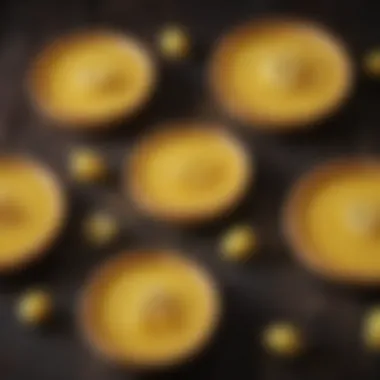
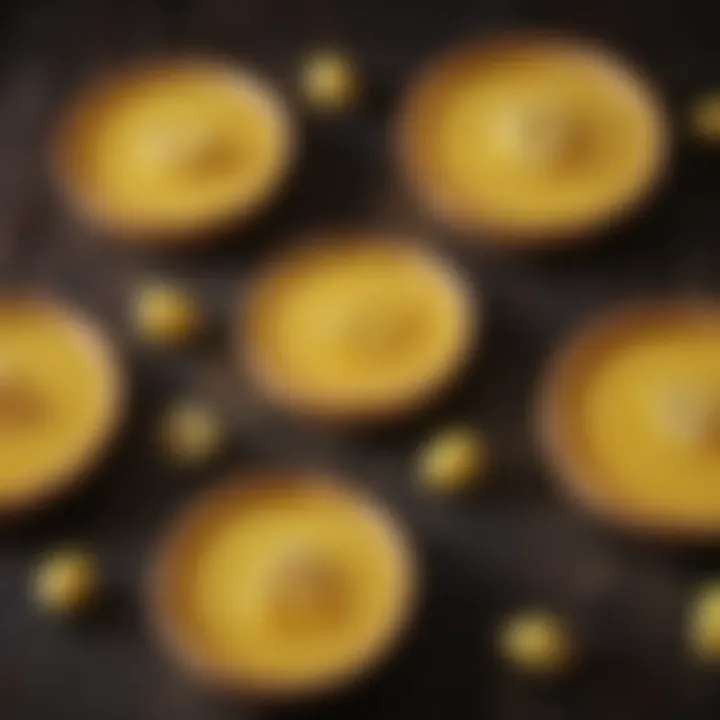
Base Ingredients
The foundational elements of a lemon tart include flour, butter, sugar, eggs, and lemons.
- Flour: Generally, all-purpose flour is used for the crust. This is what gives the tart its structure. A well-made crust is key to preventing sogginess.
- Butter: This component is essential. Its richness adds a creamy texture to the crust. Cold butter often results in flaky texture when baked. Use unsalted butter for precise control of the tart's salt content.
- Sugar: This sweetener helps balance the tartness of the lemons. Granulated sugar is the norm, thanks to its ability to melt evenly and contribute to the overall sweetness.
- Eggs: Eggs serve as a binding agent, supporting the filling’s structure. They contribute significantly to the overall texture and also aid in setting the lemon curd.
- Lemons: Fresh lemons provide the tartness for the dish. Their juice and zest are both integral for achieving vibrant flavor. Always choose lemons that feel heavy for their size, as they yield more juice.
The balance among these ingredients is utmost essential. Any swap or deviation might lead to a noticeably different texture or flavor profile. Using fresh, seasonal lemons is often recommended to elevate the flavor.
Flavor Enhancements
Flavor enhancements are what differentiate a basic lemon tart from a memorable one.
- Vanilla Extract: A small amount enhances the filling's characteristics without muddling the primary lemon flavor.
- Salt: Adding a pinch holds countervailing power to the sweetness and balances acidity.
- Herbs, such as Thyme or Basil: Pairing herbs with lemon in the filling can create unique flavor dimensions. A herbal note also works particularly well in savory variations.
- Zest from other Citrus: Adding zest—like lime or orange—can layer even more depth and complexity. This interaction brings out a richness that excites the palate distinctly.
- Optional Fine Spirits: Some recipes may include a splash of Limoncello or vodka for a complex background note and to thin the filling, resulting in a smoother consistency.
A well-crafted lemon tart balances sweetness and acidity, yielding an exquisite dessert perfect for any occasion when made with the right ingredients.
Properly leveraged, this knowledge about lemon tart ingredients not only facilitates the successful preparation of the classic dish but also unveils scope for culinary creativity. When approaching the idea of refreshing or tweaking everyday recipes, it is the nuanced adjustments that usually deliver the most gratifying results.
Types of Lemon Tart Recipes
Lemon tart recipes come in various forms, each offering a unique approach to this beloved dessert. The types you explore determine not only the flavors and textures but also the effort and time commitment involved in preparation. The richness of lemon tarts emerges from their lemony zest combined with the creaminess of the filling and the base. Understanding these distinct kinds can assist cooks of all levels in tailoring their culinary experience to suit their taste, dietary needs, and even time constraints.
Traditional Lemon Tart
A traditional lemon tart showcases a classic combination of crisp pastry and a rich, creamy lemon filling. Made with fresh lemons, eggs, and sugar, this tart often features a flaky buttery crust that provides a delicate crunch.
Some critical aspects include:
- Ingredients: Fresh lemons are a must to bring out the zest and tart flavor. Granulated sugar balances the acidity, while eggs work to set the filling.
- Baking: This tart requires careful baking. Overbaking results in a rubbery texture. Keeping a close eye on it near the end is crucial for optimal texture.
- Presentation: Dusting with powdered sugar just before serving can add elegance attributes to traditional lemon tart presentations.
Modern Variations
Modern variations of lemon tart present an exciting opportunity to experiment with ingredients and practices. These might incorporate unique flavors or alternative techniques that break from the conventional path. Different flavor combinations, such as lemon lavender or coriander, may elevate the classic tart to new levels.
The benefits of these modern takes include:
- Variety: The inclusion of different flavors creates diverse tasting experiences for enthusiasts.
- Accessibility: Many modern recipes consider dietary preferences and can easily be adjusted to be gluten-free or vegan.
- Creativity: Cooks can express their personalities through plating or by incorporating unexpected elements into the tart, such as making a meringue topping.
No-Bake Lemon Tart
In the busy lives many people lead, a no-bake lemon tart offers a convenient, yet impressive dessert option. This method eliminates the need for extensive baking, making it quicker to put together without compromising on flavor.
Key points to consider are:
- Efficiency: A no-bake version utilizes techniques like setting the filling in the fridge, which speeds up preparation time.
- Ingredients: These tarts typically have a crust made from crushed biscuits or nut meals mixed with butter and a filling made primarily of whipped cream and lemon juice.
- Presentation: Despite being simple to make, they can be plated beautifully. Topping with freshly grated lemon zest or berries can enhance their appeal.
No-bake lemon tarts are particularly likable for gatherings and occasions where time is of essence without skipping out on taste.
By understanding these distinctions, individuals are better equipped to choose which type suits their event or family preference. The connection to culture made evident through the process of preparing these varieties enhances culinary appreciation while timelessly celebrating the versatility of lemons.
Step-by-Step Guide to Making Lemon Tart
Making a lemon tart can seem daunting to novices in the kitchen, yet it presents a perfect avenue to master flavor balance and texture. The allure of this classic dessert lies in its simplicity, rich flavor, and versatility. Each step in the making of lemon tart builds a crucial layer of taste and experience, transforming primary ingredients into an exceptional dish. Incorporating a step-by-step guide can offer cooks insights into techniques that savants typically use, allowing even casual cooks to achieve professional-quality results.
Preparing the Crust
The crust sets the stage for the entire lemon tart. A well-made crust supports not only the filling but also contributes significantly to the overall texture and flavor. Common choices include a shortcrust or pâte sucrée, which combines flour, butter, and sugar. Proper measurement and ratio of these elements ensures appropriate texture.
Key Steps in Making Crust:
- Mixing the Dough: Combine flour, sugar, and pinch of salt. Cut in cold butter. It helps to use cold utensils for best results.
- Chilling: Chill the dough for about 30 minutes before rolling it out. This step prevents shrinkage during baking.
- Lining the Tart Pan: Carefully roll out the dough and press it evenly into the pan. Cutting off any excess is important for a neat finish.
Preparing the crust well is foundational for successful outcome of the lemon tart. The balance between buttery richness and cakey elements enhances the tart's enjoyment.
Creating the Filling
The filling is arguably the heart of the lemon tart. It delivers the zesty and tangy flavor crucial to its identity. Egg yolks, sugar, lemon juice, and lemon zest are the essential components. They bring out the unique bitter and sweet notes beautifully.
Steps for the Filling:
- Basic Ingredients Mixture: Combine egg yolks and sugar in a bowl. Blend them until a consistent, light mixture forms.
- Incorporating Lemon: Gradually add freshly squeezed lemon juice and zest. The relationship between these ingredients establishes the tartness that gives lemon tart its name.
- Temperature Control: Cook over low heat while continuously stirring. This combination can get curdled if too hot, so patience is key.
Creating the filling requires active attention but enriches the overall experience, ensuring that the end result captures the famous flavor profile.
Baking and Cooling Techniques
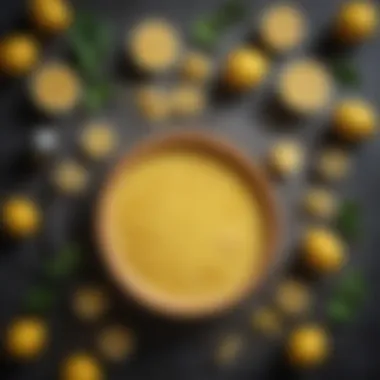
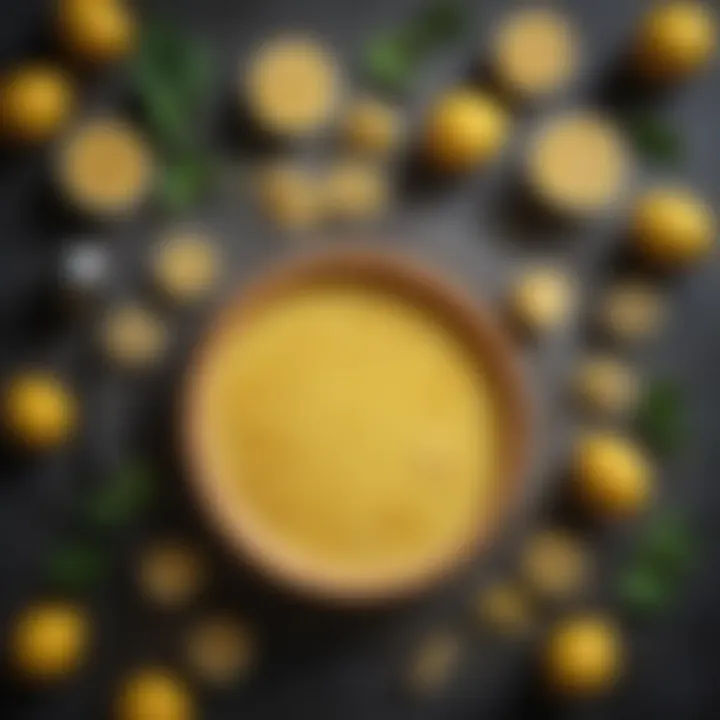
Once crust and filling are ready, baking and cooling are the final yet vital steps. Proper baking seals in flavors, while cooling allows for easy slicing and serving.
Recommendations for Baking and Cooling:
- Preheat the Oven: Ensure the oven reaches the right temperature before placing the tart. Cooking in an unheated oven can lead to unequally baked crust.
- Baking Time Monitoring: Bake until set but still maintain a slight jiggle in the center. This take usually ranges between 25 to 35 minutes.
- Cooling Time: Once out of the oven, let it cool at room temperature before refrigerating. A minimum of two hours ensures the filling solidifies appropriately.
Implementing correct techniques in baking and cooling makes a considerable difference in the smooth finish and taste quality of the dessert.
Making lemon tart can become a pursuit of culinary delight when one follows a structured approach through each stage. Pay attention, even small details can elevate the craft greatly.
Common Mistakes in Lemon Tart Preparation
Preparing a lemon tart requires precision and attention to detail. Even minor errors can profoundly affect the final outcome, making it essential to understand possible mistakes in its preparation. Being aware of these common pitfalls can help both novice and seasoned bakers produce delightful lemon tarts that satisfy.
Overbaking the Tart
Overbaking is a common issue that can gravely diminish the quality of a lemon tart. The primary characteristic of a good lemon tart is its smooth and creamy filling, which should jiggle slightly when removed from the oven. If you bake it too long, the filling can turn rubbery and dry. Achieving the perfect baking time is crucial.
Here are some tips to avoid overbaking:
- Monitor Temperature: Ensure your oven temperature is accurate and not too hot. Too much heat can fan bake the tart too fast.
- Check Early: Consider checking for doneness five to ten minutes before the recommended baking time. This way, if it needs more time, you can do so without significantly compromising the tart.
- Jiggling Test: After you remove the tart from the oven, apply gentle shaking to see if the filling holds its desired consistency. Do not be fooled by the standard visual cue of browning; it may look done while being undercooked.
Incorrect Ingredient Ratios
The proportions of ingredients are vital for balance in any baking endeavor. For a proper lemon tart, the ratios of lemons, sugar, cream, and eggs require careful measurement. An imbalance can lead to a tart too sour or overly sweet.
To avoid erroneous ingredient ratios, consider these factors:
- Use Scale: Weigh ingredients for accuracy instead of relying solely on volume measurement. Weighing can dramatically enhance consistency.
- Adjust for Preferences: Remember that personal tastes can vary. If feedback suggests too much sourness, reduce the lemon juice slightly in future batches, but maintain essential ratios of sugar to eggs for structure.
- Stick to Recipes: Initially following established recipes can help gauge the correct proportions. As you become comfortable, you can tweak the recipe, but consistency is key for beginners.
Understanding and avoiding these mistakes contributes significantly to the quality of your lemon tart. Experience in the kitchen can come with many failures, but learning from them creates a path to success.
Serving Suggestions for Lemon Tart
Serving suggestions for lemon tart are crucial to elevating the dessert experience. Lemon tart, with its bright, tangy flavor profile, is not just a standalone dish. Rather, it thrives when complemented with thoughtful pairings and garnishes. This section will explore how to enhance the enjoyment of lemon tart through beverage pairings and creative garnish techniques. Understanding these elements can transform a simple dessert into an occasion.
Pairing with Beverages
When it comes to serving lemon tart, the right beverage can amplify its flavors. The acidity and sweetness of lemon tart make it versatile in terms of drink pairings. Here are some suggestions:
- Coffee: A strong black coffee offers a contrast to the tart's brightness. The bitterness balances the sweetness, creating a harmonious combination.
- Tea: Herbal teas, especially chamomile or mint, can complement the zesty flavor of lemon tart well. Their subtle flavors enhance the lemon without overshadowing it.
- Sparkling Wine: A chilled Prosecco or Champagne can elevate the dining experience. The bubbles and acidity work together to refresh the palate.
- Lemonade or Iced Tea: These can echo the flavors of the tart itself. A richly brewed iced tea can manage the tartness well.
Choosing the right drink often depends on the setting and personal preference. Ultimately, a careful selection can enhance flavours and textures, creating a memorable dish.
Garnishing Techniques
Garnishing lemon tart is another way to impress, not only in taste but also in appearance. A well-garnished tart makes for an appealing presentation. Here are simple techniques that can be easily employed:
- Fresh Fruits: Adding slices of lemon or fresh berries can provide more color and contrast to the yellow tart. Try to use ingredients that are in season.
- Herbs: Fresh mint leaves can offer a touch of green and freshness. Placing a few leaves around the tart or on individual slices creates visual interest.
- Powdered Sugar: Sprinkling some powdered sugar lightly on top before serving enhances the visual appeal. It contrasts beautifully with the golden-brown crust.
- Zest: Incorporating lemon zest as a final touch can amplify the lemony flavor. It adds a rustic touch and can infuse additional scent, attracting eyes and noses alike.
Using these simple but effective garnishing techniques takes your lemon tart from ordinary to exceptional.
Remember, first impressions matter. A beautifully garnished lemon tart assists in compelling presentation, which can stimulate the appetite before the first bite.
Regional Variations within Australia
Understanding the regional variations of lemon tart throughout Australia is crucial for the culinary lover. Each state contributes distinct characteristics and flavors to this classic dessert, mirroring local produce, dietary habits, and cultural influences. Recognizing these unique versions broadens a cook's knowledge and accentuates their skills in making the dessert more appealing to different palates.
Emphasizing regional elements allows one to experiment with flavors. It encourages creativity in the kitchen, using seasonal and native elements. As a result, cooks can craft lemon tarts that not only satisfy individual tastes but also celebrate their local heritage.
Additionally, exploring regional trends helps in understanding broader food aspirations in Australia. Cooks can draw inspiration from local happenings, community preferences, and available ingredients—a key factor in adapting lemon tart recipes effectively.
Moreover, regional variations can enhance entertaining occasions, affecting pairing selections and presentation styles. Below, we explore lemon tart dishes popular in Queensland and Victoria, showcasing the distinct culinary landscapes of these areas.
Lemon Tart from Queensland
Queensland is well-known for its rich agricultural wealth, which plays a fundamental role in lemon tart recipes found in the region. The ripe citrus fruits here benefit from a tropical climate, resulting in flavors that are bright and zesty. Local lemon tarts often feature distinctive components such as the finger lime or Australia's native lemon myrtle.
Finger limes, in particular, add a unique twist. Their juice has a caviar-like texture with a contrasting burst of flavor that aligns well with the tartness of traditional lemon recipes. Additionally, the incorporation of lemon myrtle—known for its aromatic properties—can infuse a hint of sweetness and earthiness that deviates from the classic lemon tart taste without overwhelming it.
In Queensland recipes, one can often find variations that lean towards lighter textures. For example, mousse-like fillings are popular, resulting in a dessert that feels airy and bright, perfect for the warm Queensland weather.
Lemon Tart Trends in Victoria
In contrast, Victoria shows its flair through rich personalization in lemon tart crafting. Regional cookbooks often highlight lemons as an elegant centerpiece of Victorian high tea. Their varied uses inspire to incorporate local ingredients, like Violet Crumble crumbles for a unique, sweet crust.


Additionally, trends here often lead to decorative serving techniques. Cooks may use citrus slices or edible flowers to garnish their lemon tarts. These enhancements elevate the visual appeal, making the dessert not just tasty but aesthetically pleasing as well.
There is also an inclination towards combining flavors. Many chefs experiment with adding hints of lavender or rosemary, leaning into the trend of floral-infused treats. Such varietals cater to the sophisticated taste buds of Victorian diners.
In Pakistan, overall kitchen creativity paired with social trends is key in Victoria. These reflect an enthusiasm for experimenting, leading to lemon soup infusions and layer cakes that showcase lemony goodness in varied textures.
The evolving trends within different Australian regions highlight how lemon tart recipes adapt over time—that cultural interplay of tradition and innovation informs much of what can be discovered.
Adaptations for Dietary Preferences
Understanding dietary preferences is crucial when discussing lemon tarts. People are increasingly looking for dessert options that align with health guidelines or personal lifestyle choices. As a result, it becomes essential for recipe adaptations to consider gluten-free and vegan preferences. This does not mean sacrificing flavor or texture; rather, it can expand the dessert's appeal and satisfy a broader audience. A layered approach to adaptations can enhance overall enjoyment and inclusivity while retaining the classic essence of lemon tarts.
Gluten-Free Lemon Tart
Making a gluten-free lemon tart involves specific ingredient adjustments. One common substitute for traditional flour is almond flour. It provides a nutty flavor and a crumbly texture that works well in the tart base. You may also use gluten-free blends available in supermarkets. These blends often combine various types of flours like rice and tapioca flour, creating a balanced mixture suitable for baking.
In crafting the filling, using cornstarch as a thickening agent can be effective. It helps achieve the desired consistency without gluten. Coconut milk or heavy cream can replace dairy elements, ensuring a rich and creamy filling that remains gluten-free.
When baking, be aware that gluten-free recipes may require different techniques. Observing cooking times closely can prevent overbaking, which could lead to dryness in your tart.
Here is a simple list of gluten-free adaptations for your lemon tart:
- Use almond or gluten-free flour for the crust.
- Incorporate cornstarch for thickening the filling.
- Substitute dairy with coconut milk or heavy cream.
- Monitor baking times to prevent drying out.
Vegan Lemon Tart Options
Creating a vegan lemon tart involves eliminating all animal products, providing a refreshing alternative for those who follow a plant-based diet. An effective approach begins with the crust. Instead of butter, use coconut oil or a plant-based margarine to achieve the same flaky texture. Additionally, a blend of almond flour and oats can contribute to flavor and structure.
For the filling, the key ingredient is aquafaba, which is the liquid from canned chickpeas. Aquafaba can replace eggs, providing a similar binding effect crucial for keeping the tart intact. Blending silken tofu with the aquafaba can yield a smooth and creamy base.
Sweetness should be monitored carefully. A mix of maple syrup and agave invariably provides sweetness while maintaining a vegan label. Always remember to check labels on organic sugars and lemon products to ensure they are free from animal byproducts.
Important vegan adaptation highlights include:
- Replace butter with coconut oil or plant-based margarine.
- Use aquafaba for a binding agent instead of eggs.
- Blend silken tofu for a creamy filling.
- Use vegan-friendly sweeteners such as maple syrup.
Adapting lemon tart recipes to accommodate gluten-free and vegan preferences ultimately leads to inventive variations. Experimentation is key. Many are amazed at how these dietary adjustments enhance flavors and textures, rather than disrupt them.
The adaptations of traditional recipes not only reflect modern dietary preferences but exemplify an evolving culinary landscape that champions inclusivity.
Storing and Preserving Lemon Tart
Storing and preserving lemon tart is crucial for maintaining its freshness and flavor over time. An understanding of how to properly keep this dessert extends its shelf life, allowing you to enjoy it beyond the day of preparation. There are specific techniques that can optimize your lemon tart experience, ensuring each slice remains delicious and appealing. Proper storage techniques also aid in minimizing food waste, an important consideration for conscientious cooks.
Proper Storage Techniques
When it comes to storing lemon tart, maintaining the integrity of its texture and taste is vital. Here are key techniques to consider:
- Cool Completely: Before storing, allow the tart to reach room temperature. This helps prevent condensation from forming in the storage container, which can affect texture.
- Use an Airtight Container: Placing the lemon tart in an airtight container ensures that it is shielded from absorbing any odors from the fridge. This container should be suitable for fridge storage to mitigate flavor changes.
- Refrigeration: Lemon tart can generally be kept in the fridge for about three to four days. Be mindful of store bought tarts, as their selling point could affect freshness duration.
- Avoid Additional Garnishes: If planning for longer storage, keep any garnishes separate – this prevents wilting, which maintains visual appeal and flavor even after days.
Following these points can significantly enhance the storage life and quality of lemon tart. Remember to label your container with the date for easy reference.
Freezing Lemon Tart
If you need a solution for preserving lemon tart beyond a few days, freezing is an effective option. Understanding how to freeze the tart properly is key to retrieving its taste and consistency later on.
- Initial Freezing: Once cooled, flash-freeze the tart for a few hours. Establish a safe spot in your freezer, ideally on a flat surface, to allow it to freeze evenly.
- Wrap Carefully: After the surface is firm, wrap the tart tightly in plastic wrap. Follow with a layer of aluminum foil to protect against freezer burn while maintaining flavor.
- Labeled Container: Place the wrapped tart in a labeled freezer-safe container. Include the date and contents for easy retrieval.
- Reheating Procedures: When ready to serve, remove the tart from the freezer and let it thaw in the refrigerator overnight. Avoid room temperature thawing as this can overly soften the tart.
Utilizing these freezing techniques ensures that your lemon tart can be preserved for up to one month or more. It can be an exciting surprise to have a pre-made lemon tart ready for guests yet maintains that just-baked quality when properly executed.
Proper storage and freezing techniques can prolong the enjoyment of your lemon tart without compromising its delightful flavor.
Epilogue on Mastering Lemon Tarts
Mastering lemon tarts represents more than simply creating a dessert. It encapsulates a valuable baking skill that can elevate both everyday meals and special occasions. By understanding various aspects such as preparation techniques, key ingredient interactions, and tips for avoiding common pitfalls, cooks can enhance their abilities in the kitchen.
There is more to capturing the essence of lemon tart than just the taste. The process involves selecting quality ingredients. In the foundational recipe, attention must be paid to balancing acidity and sweetness for the ideal fresh taste. A well-prepared crust adds not only structure but also texture that complements the smooth filling. Each element plays a vital role in confirming a successful result.
Additionally, adaptations for dietary preferences demonstrate flexibility in this timeless recipe. Whether gluten-free or vegan, options abound and expand the tart’s reach, allowing more individuals to indulge without restrictions. This approach not only fosters inclusiveness but also broadens a cook's repertoire.
Further, effective storage and preservation methods from the article provide practical insights to the bakers. These considerations minimize waste, enhance flavor over time, and make it easy to enjoy the delightful taste of lemon tarts on demand.
Ultimately, recounting practical skills gleaned enhances the cooking experience for busy individuals. The direct combination of ancient tradition with modern-day needs allows everyone to interact with lemon tarts uniquely. In mastering these techniques, cooks gain confidence, leading to experimentation, innovation, and flavor exploration.
Final Thoughts
As we reflect upon the art of making lemon tarts, it is essential to think beyond creativity in the kitchen. Each recipe explored yields insights that pave the way for continuous improvement. The quest for perfection in flavor, aesthetic appeal, and overall delivery offers something significant for any passionate cook. The experience is less about preparing a dish and more about engendering confidence in one's culinary journey. After submersing in lemon tart preparations, any cook can express individuality, celebrating creative interpretation while solidifying their culinary foundations.
Crafting perfect lemon tarts unifies technique, creativity, and opportunity in expanding gastronomic horizons.
Explore, bake, and enjoy the array of lemon tart recipes, converting a classic dessert into a cherished masterpiece.







